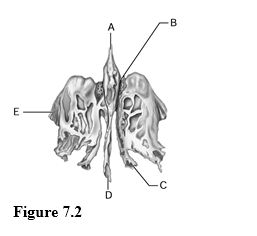Using Figure 7.2, match the following:

1) Nasal septum.
2) Turbinate bone.
3) Orbital area.
4) Olfactory bulb sits on this.
5) Nasal concha.
6) Rooster's comb.
1) D
2) C
3) E
4) B
5) C
6) A
You might also like to view...
Taste buds are found on
a) the epiglottis. b) the pharynx. c) the soft palate. d) both epiglottis and pharynx. e) All of these choices
The stronger the stimulus, the greater the frequency of action potentials generated and propagated in the afferent neuron
Indicate whether the statement is true or false
Type II alveolar cells are among the last cells to mature during fetal development. In babies born prematurely, type II alveolar cells are often not ready to perform their functions. Which of the following drugs would be most likely to help an infant with immature type II alveolar cells?
A. Pulmonary surfactant B. A muscarinic agonist C. Histamine D. A beta-adrenergic agonist E. A beta-adrenergic antagonist
Duodenal gland secretion prevents
A. digestive enzyme release. B. release of bile from the liver. C. irritation of the duodenal mucosa by acidic chyme and digestive enzymes. D. the release of insulin. E. peristalsis.